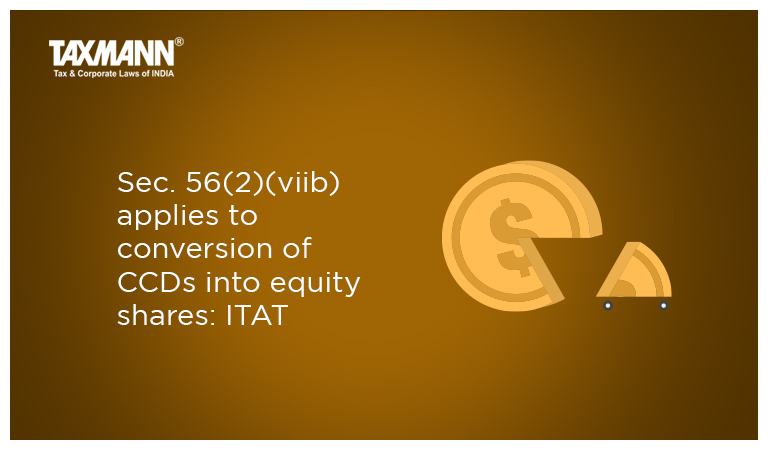Sec. 56(2)(viib) applies to conversion of CCDs into equity shares: ITAT
- Blog|News|Income Tax|
- 2 Min Read
- By Taxmann
- |
- Last Updated on 8 July, 2022

Case Details: Milk Mantra Dairy (P.) Ltd. v. DCIT - [2022] 140 taxmann.com 163 (Kolkata-Trib.)
Judiciary and Counsel Details
-
- Aby T. Varkey, Judicial Member & Girish Agrawal, Accountant Member
- Rajib Sharma & Jai Somani for the Appellant.
- Sudipta Guha, CIT DR for the Respondent.
Facts of the Case
The issue before the Kolkata Tribunal was the applicability of section 56(2)(viib) on the transaction of conversion of Compulsorily Convertible Debentures (CCDs) into Equity Shares of the assessee.
The assessee was a private limited company engaged in the manufacturing and selling of dairy products. The assessee had issued Compulsorily Convertible Debentures (CCDs) during AYs 2011-12 and 2012-13 which had been converted into equity shares during the relevant year.
The assessee contended that the entire consideration was received by the assessee at the time of issuance of CCDs. Conversion of CCDs by issuing equity shares did not entail any further payment of money. Thus, the provisions of Section 56(2)(viib) cannot be applied in the year of allotment of shares.
ITAT Held
The Kolkata Tribunal held that section 56(2)(viib) contains the words “receives any consideration”. The term “consideration” is a term of wider import when compared with the words “amounts” or “money”. Thus, section 56(2)(viib) encompasses consideration in all forms and is not limited to only receipt of money.
Receipt of money is one of the several modes for having a consideration in a transaction. Considering this, it could be said that the assessee receives as consideration on the conversion of a debt security of CCDs into equity shares which subsequently forms part of the capital base of the assessee.
Here is a list but some of the “considerations” that the assessee “receives” on the conversion of its CCDs into equity shares:
a) The debt obligation on the assessee to repay is extinguished.
b) The charge created on the assets/properties of the assessee to secure the debt obligation is released.
c) The cost of servicing the debt obligation by paying periodic interest is mitigated
d) The capital-based in the form of own fund gets widened to leverage on the capital/stock markets
e) The debt-equity ratio becomes favorable to various stakeholders of the assessee making it more investor attractive/lucrative
f) The risk of getting into the claim of insolvency resolution from the debt creditors in case of default in servicing their debt obligation is mitigated, and so forth.
Section 56(2)(viib) envisages a much wider outlook to the “receipt of any consideration” which cannot be limited to the receipt of money only.
Thus, the conversion of CCDs into equity shares entails receipt of consideration by the assessee which is translated into the total issue price of shares including share premium. Accordingly, the provisions of Section 56(2)(viib) do apply in the present case.
Disclaimer: The content/information published on the website is only for general information of the user and shall not be construed as legal advice. While the Taxmann has exercised reasonable efforts to ensure the veracity of information/content published, Taxmann shall be under no liability in any manner whatsoever for incorrect information, if any.

Taxmann Publications has a dedicated in-house Research & Editorial Team. This team consists of a team of Chartered Accountants, Company Secretaries, and Lawyers. This team works under the guidance and supervision of editor-in-chief Mr Rakesh Bhargava.
The Research and Editorial Team is responsible for developing reliable and accurate content for the readers. The team follows the six-sigma approach to achieve the benchmark of zero error in its publications and research platforms. The team ensures that the following publication guidelines are thoroughly followed while developing the content:
- The statutory material is obtained only from the authorized and reliable sources
- All the latest developments in the judicial and legislative fields are covered
- Prepare the analytical write-ups on current, controversial, and important issues to help the readers to understand the concept and its implications
- Every content published by Taxmann is complete, accurate and lucid
- All evidence-based statements are supported with proper reference to Section, Circular No., Notification No. or citations
- The golden rules of grammar, style and consistency are thoroughly followed
- Font and size that’s easy to read and remain consistent across all imprint and digital publications are applied




